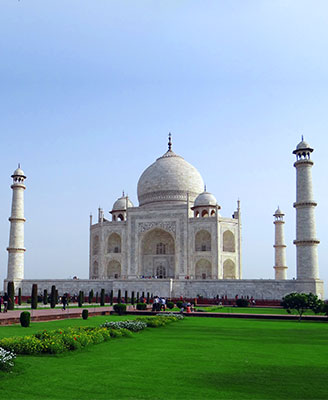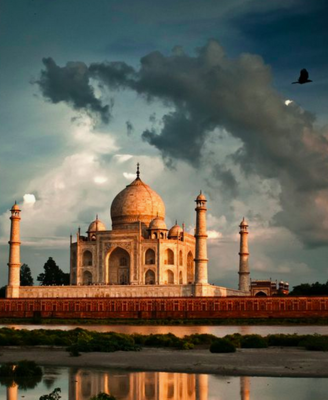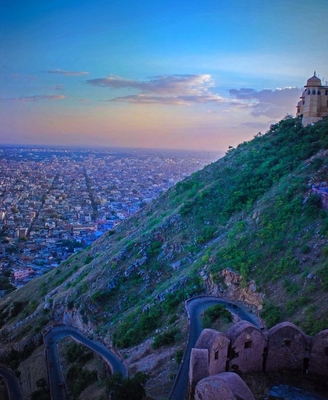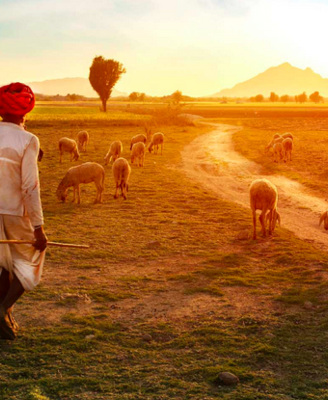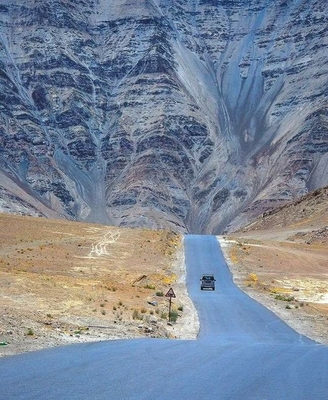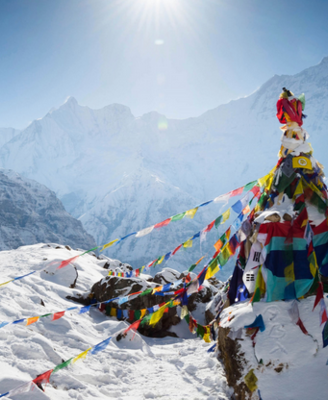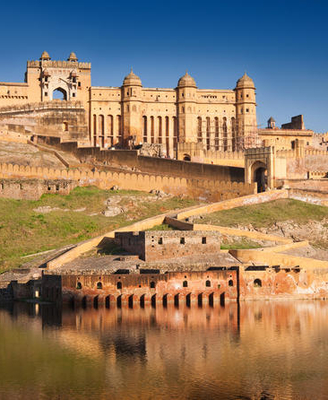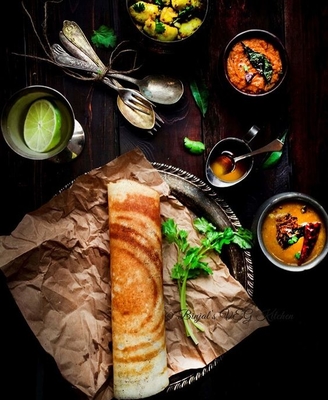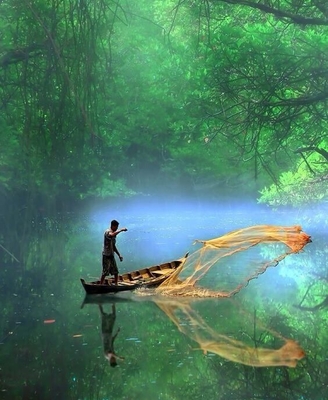On your arrival in Delhi, you will be met by our representative and transferred to hotel. Delhi was the capital of Indraprastha and capital of the Pandavas during the Mahabharata. This magnificent city has been inhabited from the 6th century BC and has been a capital of many kingdoms. It has been destroyed and rebuilt many times and is called the "city of cities". Delhi's culture has been influenced by its different rulers and the city is full of beautiful monuments. The Mughal rulers influenced the food habits of the residents and Mughlai cuisine originated here. Due to the proximity of different states, all festivals are celebrated here. Old Delhi is a maze of small lanes and old buildings and New Delhi has large road with huge buildings. Delhi is the capital of India and is the hub for politics.
Your morning tour starts with Old Delhi, built by the Mughal emperor Shah Jahan in 1639 AD. You will visit the Raj Ghat where father of our nation Mahatma Gandhi was cremated. You will be visiting the museum that was built to commemorate him. You will be driven past the iconic Red Fort and Chandni Chowk, a very popular and a busy market in Old Delhi to the next stop - Jama Masjid, one of the iconic, historic and largest mosques in India - built by Shah Jahan. A rickshaw ride in Chandni Chowk could be quite interesting as this part of the city is quite crowded as it is full of shops. These numerous shops sell delicious mouth-watering food, clothes, jewels, household, etc. and are virtually a shopper's paradise.
In the afternoon, you will visit Qutub Minar, touted as Indias largest Minaret. Qutub Minar, a UNESCO World Heritage Site, was built in 1192 by Turk ruler Qutub-Ud-Din Aibak. You will then move forward to Humayuns tomb, yet another UNESCO world heritage site. Your next stop is India Gate, built in memory of the Unknown Soldier. You will be driven past the Parliament House, Presidents House and other Government Secretarial Buildings, to your final destination which will be Lakshminarayan Temple, a temple dedicated to Lakshmi and Lord Narayana. Overnight in Delhi.
This day, you will be transferred by road from Delhi to Mandawa. Shekhawati was established by Shekhawat Rajputs and named after Rao Shekha. These kings built more than 50 forts and palaces and most of them have been converted to heritage hotels. The villages of Shekhawati are famous for the painted havelis or houses and have the highest number of frescos in the world. The Marwaris were an influential business community in this region and in the 19th century, many left their families to migrate to larger cities where they succeeded quite well. With this money, the Marwaris built large houses in these villages and to tell the world about their success, they hired artists to paint these houses and havelis.
Later, you will be visiting the Shekhawati villages like Mandawa, Nawalgarh, Dundlod, etc. In 1755, Thakur Nawal Singh founded Mandawa and it houses a collection of armories, old costumes, canons from 1820, ancient coins and other interesting items. The villages of Shekhawati have beautiful frescoes, havelis and mansions and this area is called "The Open Art Gallery". The artists painted frescos depicting mythological images of gods, goddesses and animals. The transport is at your disposal with-in the city limits. Overnight is in Mandawa or one of the villages of Shekhawati.
This morning, you will drive from Mandawa to Bikaner. In the afternoon tour of Bikaner, you will be taken to this amazing 16th century rectangular Junagadh Fort built by Raja Jai Singh, a general in army of Mughal emperor Akbar. It is one of the few oldest forts of Rajasthan constructed on ground level. The Fort with its immense beauty is a good example of ancient architecture and design and is a perfect combination of Rajput and Mughal style of architecture. Maharaja Dungar Singh in eighteenth century added a touch of western style architecture and made this fort more remarkable and beautiful.
With thirty seven pavilions, thick wall, thirty feet wide moat, large number of balconies as well as designer windows, the Fort has seven gates and one of them Suraj pol is named as the rays of sun fall directly on the gate. Chand pol is a double gate having heart winning architecture as well as design. A beautiful doorway takes you to Joramal temple, an ancient temple with breathtaking surrounding and interior. Visit the Har Mandir, a royal temple dedicated to goddess Lakshmi and lord Vishnu, which was used by kings and princes for celebrating special occasions like marriage ceremonies and festivals. The transport is at your disposal with-in the city limits. Overnight is in Bikaner.
This day, you will be transferred by road from Bikaner to Jaisalmer. Situated in the Thar Desert of Rajasthan, Jaisalmer has is a colorful treasure chest of art, music, architecture, culture and tradition. The Golden City of India as Jaisalmer is popularly known, is one of the most fascinating places and the yellow sand, camel safaris, magnificent palaces, marvelous havelis and beautiful Jain temples here will leave you in enchantment. Jaisalmer is mystical and interesting and the glorious heritage and the lively air of this city will blow your mind away. You have an option to get away from the bustling city and camp in the desert. Lose yourself in the charms of this cultural land of sand and see how many beautiful memories you gain. The afternoon is free for visiting the interesting bazaars or you could take an excursion into the desert and enjoy a camel safari. The transport is at your disposal with-in the city limits. Overnight is in Jaisalmer.
In the morning, your first travel destination is the Jaisalmer Fort which is one of the oldest living forts of the world. The fort is constructed by using an yellow stone which from a distance makes its shine like it is made of gold, due to which it is also known as "Sonar Quila" or "The Golden Fort". Located in midst of sandy terrains, the 12 the century fort is a blend of Indian architecture with Military designs crafted on it. The palaces of Maharwals contain ornamental designs of wooden carvings that enhance the beauty of this fort. You will get to see a 5 storied Tazia Tower in this fort which reflects architectural skills of local craftsmen during ancient period.
The next stop in your program will be visit to some of the havelis. Salim Ji Ki Haveli made up of yellow sandstone with balconies designed in different styles of architecture still has a large number of people residing here. Designed beautifully, the Haveli is built in with intricate roof carvings and served as residence for Mohta family for decades. It has exquisitely carved pillars painted with beautiful ornaments of Gold and silver. Visit some other Havelis, Patwon ki Haveli, etc which depict an interesting piece of architecture built of the ancient times. Afternoon is at leisure to visit the bazaars or the numerous Jain Temples. The transport is at your disposal with-in the city limits. Overnight is in Jaisalmer.
This morning, you will be driven to Jodhpur, the second largest city of Rajasthan. Jodhpur also known as the Sun City or the Blue City is the second largest city in Rajasthan and was the former capital of Marwar kingdom. It is named after its founder Rao Jodha who established this city in 1459. The city was in the route of Delhi to Gujarat and was a trading centre for copper, opium, silk, etc. Jodhpur is quite known for its festivals and fairs and Gangaur, Teej, Nag Panchmi, etc are celebrated with a big pomp. The Jodhpur sweets are quite known throughout India. Jodhpur has become an important centre for big weddings and also for movie shootings.
In the afternoon, you will be taken to Meherangarh fort, one of the largest forts in not only Rajasthan but in India as well, situated on a low sandstone hill, at an altitude of 120 meters. The fort with menacing thick walls contains many palaces with expansive courtyards and intricate carvings. Moti Mahal - the Pearl Palace, is one of the beautiful palaces situated in the fort and was built by Raja Sur Singh. Later you will be taken to Phool Mahal - the Palace of Flowers, built by Maharaja Abhaya Singh, and believed to be an exclusive and private chamber of pleasure.
You will visit Jaswant Thada, built in 1889 by Sardar Singh in remembrance of Maharaja Jaswant Singh II. The entire structure is constructed out of thin and polished sheets of Marble which makes it ever so beautiful when sunlight falls over it. Your visit continues to Umaid Public Gardens which houses the Government Museum and the Umaid Bhawan Museum, with a vast collection of artifacts displaying rich history of region. Museum as well as the Umaid palace was designed by Henry Vaughan Lanchester. The transport is at your disposal with-in the city limits. Overnight is in Jodhpur.
In the morning you will be transferred by road from Jodhpur to Udaipur. On the way, 98 km from Udaipur, you will be stopping at Ranakpur to visit the beautiful Jain Temples from 15th century. The popular Chamukha temple of Ranakpur made of marble is dedicated to Adinathji the first Tirthankara. It is composed of more than twenty halls and 1444 pillars which are not similar to each other. The shade and lights of this place is really outstanding and is a real treat to your eyes. If time permits, you could also visit the Surya Temple and the Jain Temple. After the visit, you will drive to Udaipur where you will have a free time in the evening in the city of lakes.
Udaipur known as the City of Lakes, or the Venice of the East was the historic capital of the kingdom of Mewar and founded by Rana Udai Singh in 1559. The legendary Maharana Pratap was born in Udaipur who fought against Emperor Akbar in 1576 and is remembered for his bravery. Maharana means the Great Warrior, and the one from Udaipur is the head of all the Rajput clans. In the 12th century the Parihara prince of Mandore awarded the title of Rana to the Prince of Mewar. The rulers from this dynasty are called Suryavanshis (descendents of the Sun) and have the Sun as their insignia. A stay in the Lake Palace hotel situated in the middle of a lake is like a dream. The transport is at your disposal with-in the city limits. Overnight is in Udaipur.
In the morning, your tour starts with the City Palace, situated on the bank of Pichola Lake. This Palace was constructed by Maharana Udai Mirza Singh in 1559 A.D. Your next stop is the Jagdish Temple built by Maharana Jagat Singh. The architecture of this temple is based on Indo-Aryan style and is dedicated to Lord Vishnu and is one of the biggest shrines of Udaipur. You will be taken on a drive around Fatehsagar Lake, built in 1678 by Maharana Fateh Singh. Your next stop will be at Bhartiya Lok Kala Mandir located near Chetak Circle. It is one of most renowned museums of Udaipur, exhibiting the dazzling gathering of folk articles of Rajasthan. Your final destination will be at Sahelion ki Bari (Queen's resort for her friends). Afternoon is at leisure for discovering the various bazaars. The transport is at your disposal with-in the city limits. Overnight in Udaipur.
In the morning, you will be transferred by road from Udaipur to Pushkar. In the afternoon, you will be visiting Pushkar - one of the most sacred pilgrimages for Hindus and considered to be one of the oldest existing cities in India and it is said that Lord Brahma created this holiest of cities for the Hindus. When a demon Vajra Nabha killed Brahma's children, Brahma hit him with a lotus flower which killed the demon. A lotus petal fell in Pushkar and a lake was formed where Brahma performed a sacrifice on a full moon day. A temple dedicated to Brahma is the only one of its kind in the world. Hindus believe that bathing in the lake will ensure salvation. Pushkar is famous for its Camel fair when thousands of camels and cattle are traded. The transport is at your disposal with-in the city limits. Overnight is in Pushkar.
Early in the morning, you will be driven to Jaipur. Jaipur, also known as the pink city is the capital of Rajasthan. Many captivating palaces are present here having breathtaking design and architecture. In the 18th century Prince of Wales had visited Jaipur and the entire city was painted in pink color and due to these pink buildings the city is known as the pink city. Origin of Jaipur lie 260 year back. It was built by Maharaja Jai Singh and Jaipur got its name from this king. The rest of the day could be spent visiting the Jaipur bazaars or walking down the crowded colorful streets. The transport is at your disposal with-in the city limits. Overnight is in Jaipur.
The morning journey starts from Amer fort also known as Amer Palace, the earlier capital of Jaipur. This magnificent fort was constructed in red sand-stone and marble by Raja Man Singh and is divided into four sections each with a courtyard. The main entrance gate is Surajpol having a fascinating architecture. Near the Ganesh Gate, there is a temple dedicated to the Goddess Sila Devi. The Diwan-e-Aam - hall of public audience, Diwan-e-Khas - hall of private audience, Sheesh Mahal - palace of mirrors and Sukh Niwas are quite beautiful. At the he Sukh Niwas, a pleasant climate is created by winds that blow over a water cascade. You could ascend the fort by walking up the steps or on an elephant's back or in jeeps.
In Jaipur you will be taken to Maharaja City Palace, a royal palace with seven storey as well as Jantar Mantar, the observatory. This wonderful observatory attratcs mathematicians as well as astronomers from the whole world. City palace is perfect blend of all three excellent styles (Mughal, Rajput and European). Another palace, Hawa Mahal is popular all over world for it magnificent architecture. You will be taken through pink rose garden as well business centers of Jaipur. A tour of Jaipur is not complete without shopping. Jaipur is famous for clothes, carpets, precious and semi-precious stones and jewelry and various handicrafts made of wood, metals, etc. and also for silk paintings and miniatures. The transport is at your disposal with-in the city limits. Overnight is in Jaipur.
This morning, you will be transferred from Jaipur to Agra enroute visiting Fatehpur Sikri, built in the 16th century by Emperor Akbar. Fatehpur Sikri holds exceptional testimony to Mughal civilization and is one of the well-known UNESCO World heritage site of India and has various historical monuments. You will visit the Jama Masjid, followed by the Tomb of Salim Chishti, the five storied Panch Mahal and Buland Darwaza a graceful monument and stupendous piece of beautiful architectures. It is central portico with a total of three arched entrances and is locally known as Horseshoe gate. You will visit the other graceful buildings of this place such as Ibadat Khana, Mariam-uz-Zamani's palace, Naubat Khana and Birbal's house. Later you will be driven to Agra. Afternoon is at leisure. The transport is at your disposal with-in the city limits. Overnight is in Agra.
Agra the former capital of Hindustan is a city on the banks of the river Yamuna. Agra is a major tourist destination of India and a part of the Tourist Circuit of Golden Triangle along with Delhi and Jaipur. Agra also known as Akbarabad went through its peak during the time of Mughals and was the capital of under the Mughal rulers Akbar, Jahangir and Shahjehan. In the morning visit of Agra, you will be taken to Taj Mahal, one of the wonders of the world. This beautiful building is elegantly built with white marble by the Mughal Emperor Shah Jahan between the years 1631 to 1648 and it was built in the memory of his favorite beloved Queen Mumtaz Mahal. Standing majestically on banks of Yamuna River, this breathtaking, immensely beautiful monument is synonymous to romance and love.
Your next stop Agra Fort is a UNESCO World Heritage Site and known for its architectural structure and was built in the 16th century during the Mughal Empire. This place comprises of several fairy-tale palaces like Khas Mahal and Jahangir Palace. Over here you will also get a chance to see Diwan-e-Aam and Diwan-e-Khas, which are also known as private audience hall and public audience hall. Afternoon can be spent visiting more places of interest or shopping. Agra is famous for inlaid marble work and handicrafts made of marble, wood and metal. The transport is at your disposal with-in the city limits. TAJ MAHAL IS CLOSED ON FRIDAYS. Overnight is in Agra.
This morning you will be transferred Agra to Gwalior by road. On your arrival in Gwalior, you will be transferred to your hotel. Gwalior, a historical town renowned for the sacred temples, outstanding palaces, as well as glorious monuments was founded by the King Surajesan. The legend is that Prince Suraj Sen lost his way in the jungle. On meeting a sage Gwalipa the Prince asked for water and was led water which quenched his thirst as well as cured him of leprosy. In return, the sage asked him to construct a wall to protect the sages from wild animals. The Prince obliged and named the place Gwalior after the sage. Gwalior is the birth-place of world class musician Tansen and every winter a huge cultural festival is organized in memory of Tansen, which attracts music lover from across the world.
In the afternoon Gwalior tour you will be taken to the Man Mandir from the 16th century, the Gujari Mahal which is now an archaeological museum, Teli Ka Mandir - a beautiful tall structure of about 100 feet, the 9th century Sas-bahu Temple that allures devotees to this place, Jai Vilas Palace - a European style palace of European type that now has been transformed into a museum, Mausoleum of the Tansen, Tomb of the Gaus Mohammad and of course the bazaars. Gwalior is an old town with a different charm and is worth visiting. The transport is at your disposal with-in the city limits. Overnight in Gwalior.
You will be transferred by road from Gwalior to Orchha. You will be visiting Orchha in the afternoon. Orchha was established in the 15th century AD by Rudra Pratap Singh, the first king of Orchha. The Orchha Fort was also built by the same king. Orchha Fort consists of several constructions like Raja Mahal, Jahangir Mahal, etc. Raj Mandir was built by 'Madhukar Shah' during 1554 to 1591 AD and the Chaturbhuj Temple was built by Queen Ganeshi Bai. You could climb the roof of the camel shelter "Uth Khana" for a beautiful view of Orchha. This is where the camels of the kings were held. The Orchha town has numerous temples and tombs and the fort has plenty of cenotaphs. The transport is at your disposal with-in the city limits. Overnight is in Orchha.
This morning you will be transferred by road from Orchha to Khajuraho. On your arrival in Khajuraho, you will be assisted in check-in at your hotel. Khajuraho is known for its erotic and beautiful temples. These temples were constructed by the Chandelas during 950 AD to 1050 AD. After the period of Chandelas, these temples were forgotten and covered with dense palm-date trees. The name Khajuraho comes from the date trees known as Khajur trees in Hindi. In the year 1838, Capt. T.S. Burt and an engineer from British army re-discovered this place.
Your afternoon visit of Khajuraho will take you to the different temples. The Khajuraho sight-seeing will take you to temples like Chaunset Yogini Kali Temple, Bharatji or Chitragupta temple that is composed of magnificent 11 headed pictures of Lord Vishnu, Lakshmana Temple, Mahadev Temple, Nandi & Vishvanath Temples and Shiva Visha Temple. The Parasvanath Temple of Khajuraho is the only Jain temple that still exists. The Javeri Temple is dedicated to the Hindu Lord Vishnu. The other temples you can visit are dedicated to Lord Brahma, Lord Adinath and Yamuna. The transport is at your disposal with-in the city limits. Overnight is in Khajuraho.
This day, you will be transferred to airport to board flight for Varanasi. Arrive Varanasi & transfer to hotel. The rest of the day is at leisure to discover the city or visit Sarnath. The evening Arti at the River Ganges Ghats is worth watching. Or a stroll in the busy bazaars of Varanasi also called Benaras or Banaras or Kashi will be quite interesting. Varanasi is said to be the oldest living city in the world, dating back to 5000 years. It has been the cultural and spiritual capital of North India for years. The belief of Hindus is that death in Varanasi leads to salvation. Varanasi is also known as the holy city of India or the city of temples, or the city of learning and also as the oldest living city on earth. Overnight is in Varanasi.
Your morning boat excursion on the river Ganges will take you the different ghats. Two of most renowned ghats, Manikarnika and Harishchandra ghats, which are frequented by hundreds of devotees. These two ghats are quite famous not only for taking a holy dip, but also for cremation purposes. It is strongly believed by Hindus that whoever dies in Varanasi and gets cremated on bank of river Ganga achieves salvation, thereby releasing him form this birth cycle. You may witness numerous funeral pyres burning around in these ghats. Afternoon is at leisure. Overnight is in Varanasi.
You will be transferred to airport to board flight for Delhi. On your arrival in Delhi you will connect to your return/onwards flight. As most of the flights depart after mid-night, accommodation is not included in Delhi. Depart for your return/onward journey.
END OF THE TOUR.
On your arrival in Delhi, you will be met by our representative and transferred to hotel. Delhi was the capital of Indraprastha and capital of the Pandavas during the Mahabharata. This magnificent city has been inhabited from the 6th century BC and has been a capital of many kingdoms. It has been destroyed and rebuilt many times and is called the "city of cities". Delhi's culture has been influenced by its different rulers and the city is full of beautiful monuments. The Mughal rulers influenced the food habits of the residents and Mughlai cuisine originated here. Due to the proximity of different states, all festivals are celebrated here. Old Delhi is a maze of small lanes and old buildings and New Delhi has large road with huge buildings. Delhi is the capital of India and is the hub for politics.
Your morning tour starts with Old Delhi, built by the Mughal emperor Shah Jahan in 1639 AD. You will visit the Raj Ghat where father of our nation Mahatma Gandhi was cremated. You will be visiting the museum that was built to commemorate him. You will be driven past the iconic Red Fort and Chandni Chowk, a very popular and a busy market in Old Delhi to the next stop - Jama Masjid, one of the iconic, historic and largest mosques in India - built by Shah Jahan. A rickshaw ride in Chandni Chowk could be quite interesting as this part of the city is quite crowded as it is full of shops. These numerous shops sell delicious mouth-watering food, clothes, jewels, household things, etc. and are virtually a shopper's paradise.
In the afternoon, you will visit Qutub Minar, touted as India's largest Minaret. Qutub Minar, a UNESCO World Heritage Site, was built in 1192 by Turk ruler Qutub-Ud-Din Aibak. You will then move forward to Humayun's tomb, yet another UNESCO world heritage site. Your next stop is India Gate, built in memory of the Unknown Soldier. You will be driven past the Parliament House, President's House and other Government Secretarial Buildings, to your final destination which will be Lakshminarayan Temple, a temple dedicated to Lakshmi and Lord Narayana. Overnight is in Delhi.
This day, you will be transferred by road from Delhi to Mandawa. Shekhawati was established by Shekhawat Rajputs and named after Rao Shekha. These kings built more than 50 forts and palaces and most of them have been converted to heritage hotels. The villages of Shekhawati are famous for the painted havelis or houses and have the highest number of frescos in the world. The Marwaris were an influential business community in this region and in the 19th century, many left their families to migrate to larger cities where they succeeded quite well. With this money, the Marwaris built large houses in these villages and to tell the world about their success, they hired artists to paint these houses and havelis.
Later, you will be visiting the Shekhawati villages like Mandawa, Nawalgarh, Dundlod, etc. In 1755, Thakur Nawal Singh founded Mandawa and it houses a collection of armories, old costumes, canons from 1820, ancient coins and other interesting items. The villages of Shekhawati have beautiful frescoes, havelis and mansions and this area is called "The Open Art Gallery". The artists painted frescos depicting mythological images of gods, goddesses and animals. The transport is at your disposal with-in the city limits. Overnight is in Mandawa or one of the villages of Shekhawati.
In the morning, you will be transferred by road from Mandawa to Pushkar. In the afternoon, you will be visiting Pushkar - one of the most sacred pilgrimages for Hindus and considered to be one of the oldest existing cities in India and it is said that Lord Brahma created this holiest of cities for the Hindus. When a demon Vajra Nabha killed Brahma's children, Brahma hit him with a lotus flower which killed the demon. A lotus petal fell in Pushkar and a lake was formed where Brahma performed a sacrifice on a full moon day. A temple dedicated to Brahma is the only one of its kind in the world. Hindus believe that bathing in the lake will ensure salvation. Pushkar is famous for its Camel fair when thousands of camels and cattle are traded. The transport is at your disposal with-in the city limits. Overnight is in Pushkar.
This morning, you will be driven to Jaipur. Jaipur, also known as the pink city is the capital of Rajasthan. Many captivating palaces are present here having breathtaking design and architecture. In the 18th century Prince of Wales had visited Jaipur and the entire city was painted in pink color and due to these pink buildings the city is known as the pink city. Origin of Jaipur lie 260 years back. It was built by Maharaja Jai Singh and Jaipur got its name from this king. The rest of the day could be spent visiting the Jaipur bazaars or walking down the crowded colorful streets. The transport is at your disposal for any additional visits of monuments or restaurants or places of interest which are with-in the city limits. Overnight is in Jaipur.
The morning journey starts from Amer fort also known as Amer Palace, the earlier capital of Jaipur. This magnificent fort was constructed in red sand-stone and marble by Raja Man Singh and is divided into four sections each with a courtyard. The main entrance gate is Surajpol having a fascinating architecture. Near the Ganesh Gate, there is a temple dedicated to the Goddess Sila Devi. The Diwan-e-Aam - hall of public audience, Diwan-e-Khas - hall of private audience, Sheesh Mahal - palace of mirrors and Sukh Niwas are quite beautiful. At the Sukh Niwas, a pleasant climate is created by winds that blow over a water cascade. You could ascend the fort by walking up the steps or on an elephant's back or in jeeps.
In Jaipur you will be taken to Maharaja City Palace, a royal palace with seven storey as well as Jantar Mantar, the observatory. This wonderful observatory attracts mathematician as well as astronomers from the whole world. City palace is perfect blend of all three excellent styles (Mughal, Rajput and European). Another palace, Hawa Mahal is popular all over world for it magnificent architecture. You will be taken through pink rose garden as well business centers of Jaipur. A tour of Jaipur is not complete without shopping. Jaipur is famous for clothes, carpets, precious and semi-precious stones and jewelry and various handicrafts made of wood, metals, etc. and also for silk paintings and miniatures. The transport is at your disposal with-in the city limits. Overnight in Jaipur.
This morning, you will be transferred from Jaipur to Agra enroute visiting Fatehpur Sikri, built in the 16th century by Emperor Akbar. Fatehpur Sikri holds exceptional testimony to Mughal civilization and is one of the well-known UNESCO World heritage site of India and has various historical monuments. You will visit the Jama Masjid, followed by the Tomb of Salim Chishti, the five storied Panch Mahal and Buland Darwaza a graceful monument and stupendous piece of beautiful architectures. It is central portico with a total of three arched entrances and is locally known as Horseshoe gate. You will visit the other graceful buildings of this place such as Ibadat Khana, Mariam-uz-Zamani's palace, Naubat Khana and Birbal's house. You will be driven to Agra where you have the afternoon at leisure. Overnight in Agra. The transport is at your disposal with-in the city limits. Overnight is in Agra.
Agra the former capital of Hindustan is a city on the banks of the river Yamuna. Agra is a major tourist destination of India and a part of the Golden Triangle tourist circuit along with Delhi and Jaipur. Agra also known as Akbarabad went through its peak during the time of Mughals and was the capital of under the Mughal rulers Akbar, Jahangir and Shahjehan. In the morning visit of Agra, you will be taken to Taj Mahal, one of the wonders of the world. This beautiful building is elegantly built with white marble by the Mughal Emperor Shah Jahan between the years 1631 to 1648 and it was built in the memory of his favorite beloved Queen Mumtaz Mahal. Standing majestically on banks of Yamuna River, this breathtaking, immensely beautiful monument is a synonymous to romance and love.
Your next stop Agra Fort is a UNESCO World Heritage Site and known for its architectural structure and was built in the 16th century during the Mughal Empire. This place comprises of several fairy-tale palaces like Khas Mahal and Jahangir Palace. Over here you will also get a chance to see Diwan-e-Aam and Diwan-e-Khas, which are also known as private audience hall and public audience hall. Afternoon can be spent visiting more places of interest or shopping. Agra is famous for inlaid marble work and handicrafts made of marble, wood and metal. The transport is at your disposal with-in the city limits. TAJ MAHAL IS CLOSED ON FRIDAYS. Overnight is in Agra.
This day you will be transferred to Agra rail-station in time for your Jhansi train. Arrive at Jhansi and drive to Khajuraho. On your arrival in Khajuraho, you will be assisted in check-in at your hotel. Khajuraho is known for its erotic and beautiful temples. These temples were constructed by the Chandelas during 950 AD to 1050 AD. After the period of Chandelas, these temples were forgotten and covered with dense palm-date trees. The name Khajuraho comes from the date trees known as Khajur trees in Hindi. In the year 1838, Capt. T.S. Burt and an engineer from British army re-discovered this place. Rest of the day is at leisure. Overnight is in Khajuraho.
Your morning visit of Khajuraho will take you to the different temples. The Khajuraho sight-seeing will take you to temples like Chaunset Yogini Kali Temple, Bharatji or Chitragupta temple that is composed of magnificent 11 headed pictures of Lord Vishnu, Lakshmana Temple, Mahadev Temple, Nandi & Vishvanath Temples and Shiva's Visha Temple. The Parasvanath Temple of Khajuraho is the only Jain temple that still exists. The Javeri Temple is dedicated to the Hindu Lord Vishnu. The other temples you can visit are dedicated to Lord Brahma, Lord Adinath and Yamuna. Afternoon is at leisure. Late evening you will be transferred to rail-station in time for your Varanasi train. (This train does not run daily). Overnight is on board the train.
This morning, on your arrival in Varanasi, you will be transferred to your hotel. The rest of the day is at leisure to discover the city or visit Sarnath. The evening Arti at the River Ganges Ghats is worth watching. Or a stroll in the busy bazaars of Varanasi also called Benaras or Banaras or Kashi will be quite interesting. Varanasi is said to be the oldest living city in the world, dating back to 5000 years. It has been the cultural and spiritual capital of North India for years. The belief of Hindus is that death in Varanasi leads to salvation. Varanasi is also known as the holy city of India or the city of temples, or the city of learning and also as the oldest living city on earth. Overnight is in Varanasi.
Your early morning boat excursion on the river Ganges will take you the different ghats. Two of the most renowned ghats are Manikarnika and Harishchandra ghats, which are frequented by hundreds of devotees. These two ghats are quite famous not only for taking a holy dip, but also for cremation purposes. It is strongly believed by Hindus that whoever dies in Varanasi and gets cremated on bank of river Ganga achieves salvation, thereby releasing him from this birth cycle. You may witness numerous funeral pyres burning around in these ghats. Afternoon is at leisure or an optional visit to Sarnath is quite interesting. Sarnath was the deer park where Buddha gave his first sermon after attaining enlightenment where he taught of the four noble truths. Later in the evening, transfer to rail-station in time for your Delhi train. Overnight is onboard the train.
On arrival in the morning, you will be transferred to your hotel. You have a free day in Delhi. Or you could opt for additional visits of Delhi. You could visit Swaminarayan Akshardham which is one of the world's largest temple complexes and built from Rajasthani pink sandstone and Italian marble. In this Hindu temple complex, there are statues of Swaminarayan, Sita Ram, Radha Krishna, Shiva Parvati, and Lakshmi Narayan. The main temple was built as per Vastu and Pancharatra Shastra and the main monument has carved details of flora, fauna, dancers, musicians, and deities. The temple has 234 pillars, nine domes, 20,000 idols of sages and 148 of full sized elephants. Yagnapurush Kund is a larges step well with a musical fountain. A short boat ride takes you through 10,000 years of Indian history. Overnight is in Delhi.
This morning you will be transferred to airport for your return/onward journey.
END OF THE TOUR.


